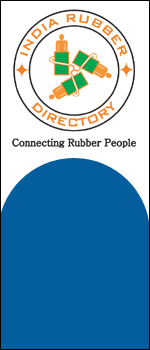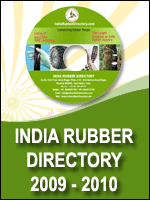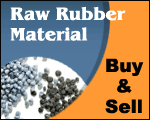Articles - Rubber Technical Papers
TACK TESTER
The Uniroyal Goodrich-Patented Tack Tester is a portable, computer based
electromechnical test instrument used to quantitatively evaluate tack
of uncured rubbers and compounds. The tester measures tack by bringing
together two samples for a short contact time and then separating them.
Both the contact time and contact pressure of the sample are controlled.
The Sample holding grips are capable of holding a wide variety of samples.
Both fabric-reinforced (i.e. carcass, belt) and non-reinforced (i.e.tread
sidewall) stocks can be tested. Therefore, nospecial sample preparation
is needed. Contact pressure and contact time are controlled.
A force and time curve can be obtained after each test. Data acquisition
and analysis are done by a computer. Printout for each test includes test
number, data and time, contact pressure, peak load, peak stress, energy
and tack. Normally five (5) specimens of each stock are tested to get
the average values.
The Task Tester is used by UGTC tyre plants for tack surbeillance of
comounds an d tyre components. A typical example for tyre plant tack chart
is shown in Figure 6. We have found excelent correlations between tack
values obtained by using the Tack Tester and tyre building experience.
MOVING DIE RHEOMETER (MOR)
Introduced last year by Monsanto for rubber industry applications, the
MDR represents combination of some of the latest technologies in precision
controls and data acquisition systems.
It measures the cure charcteristics (2)of rubber compounds by using a
pressurized, sealed rotorless, moving die system. The bottom die oscillates.
throuth a selected arc, at 100 cpm (1.66 Hiz) and the upper die, equipped
with a torque transducer, measures the torque generated by sample as it
cures. A sample is sealed in a cavity formed by dies that are now heated
rapidly to provide fast thermal recovery. The actual die temperatures
are displayed at the end of the test. The foce-measuring system is redesigned
completely.
The equipement is capable of providing torque values at 16 different
times for a given curve. Besides providing classic curemeter data and
torque-time curve, the MDR generates dynamic mechnical properties through
continuous measures of stroage modulus (E’) and loss modulus (E’’).
TanÔ (E”/E’) values can also be obtained. The E’
curve is the analogue of th e classic Oscillating Disc Rheometer (ODR)
torque time curve. For a given test, any two (of E’,E”, and
tanÔ) can be plotted simultaneously as the sample cures. See Figure
7.
Figure 7. MDR S’ and Tan Ô Curves.
MDR is good quality control tool. The statistical system stores and
analyses data and plots on the control chart. The operator can transmit
any part of the data to another location, e.g. control room; or can receive
messages from a remote computer for display.
Because of rapid thermal recovery of dies, the MDR had been identified
to generate cure curves 20-40% faster.
MTS DYNAMIC MECHANICAL TESTER
One can call it almost a unversal test instrument for dynamic mechnical
property testing of materials. It provides the ability to test under extensional
deformation in either tension/compression at adjustable strain rate or
in oscillation when both firquency and wave form can be selected. Testing
may be performed in load, displacement or strain control.
The type of materials that can be tested on this tester includes rubbers,
plastics, composites, theirmosetting resins, testiles and metals. The
test specimen geometry can be a strip, dumbbell, rod, solid cylinders,
or hollow cylinders; depending on the type of material property needed.
MTS 831 is the latest in this series of dynamic mechanical testers. It
used the IBM computer for data acquisition and data analysis. Frequency
operating range is 0-1000 Hz, and test temperature range is-100 to+300
C. Temperature and frequency sweeps are available. Storge modulus (E’),
loss modulus (e”), complex modulus (E*), tan (E”/E’), storage
compliance (J’), loss comliance (J”), and damping coefficients
(c) can be measured. Control limits. (pass, fail) can be set up for any
combination of these properties for quality control purpose. See Table
I.
TABLE 1.
MTS DYNAMIC MECHANICAL TEST DATA
| Specimen ID |
SAMPLE A |
| Test Date |
Aprii 6, 1989 |
|
|
| Start Time |
10:33:38 |
Diameter (mm) |
16.72 |
| End Time |
10:34:21 |
Height (mm) |
25.12 |
| Comments: |
TESTED AT 70 C |
|
|
| Condition |
|
|
|
| |
E’ (MPa) |
E” (MPa) |
Tan Delta |
| 1 |
9.362E+00 Pass |
1.316E+00 Pass |
1.40E-01 Pass |
| 2 |
8.57E+00 Fail |
1.188E+00 Fail |
1.474E-01 Pass |
| 3 |
7.375E+00 Fail |
.106E+00 Fail |
1.500E-01 Pass |


























